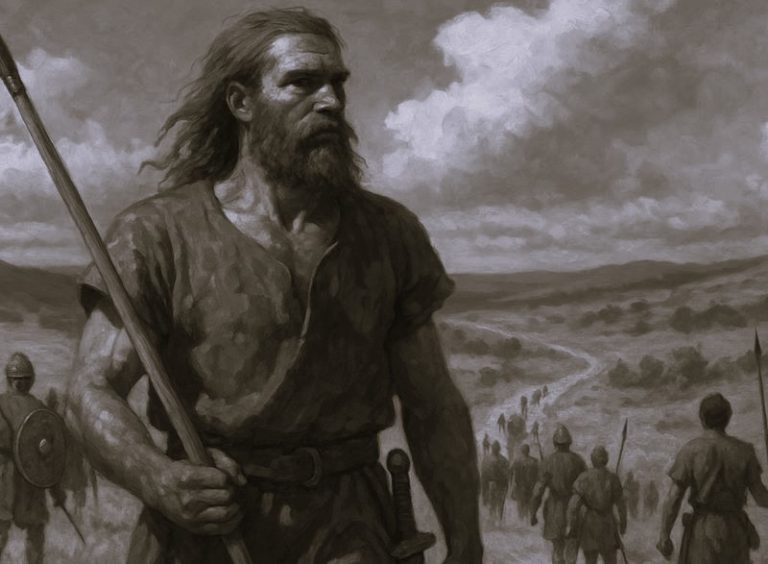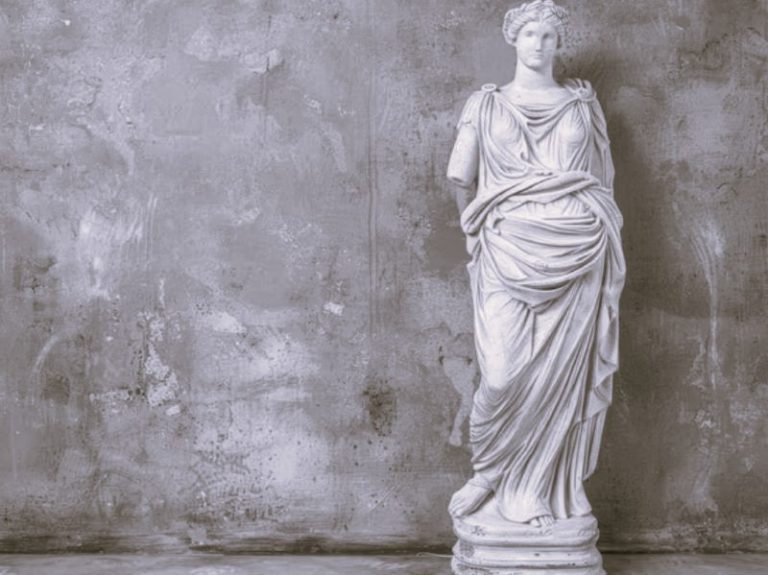

Gütschow was among the first women to play a prominent role in the development of the archaeological discipline.

By Dr. Raffaella Bucolo
Research Fellow
Museum of Classical Art
Sapienza University
Margarete Gütschow is not well-known in the history of archaeology, but she should be included among the first women who played a prominent role in the development of the discipline. Gütschow’s life story, found partly within her correspondence, has allowed us to understand the personality and the role of this scholar as part of the German Archaeological Institute in Rome, where she worked for many years, most notably as an assistant of Gerhart Rodenwaldt. Gütschow’s case is quite unique for her time, she was born in 1871 and she could only enter university at a more mature age than men in her field. The social situation in Germany, her family expectations, and her late education, are very interesting angles by which we can investigate Gütschow’s choices, which led her to look for a position in a predominantly-male scientific field. She led a successful career, and had received the title “Ordinary Member of German Archaeological Institute” by 1935.
Margarete Gütschow (1871–1951) was among the first women to play a prominent role in the development of the archaeological discipline. Her personality and life trajectory offer valuable insights into the early history of the discipline and her contribution to it as part of the German Archaeological Institute in Rome, where she worked for many years.
Margarete Gütschow was born in Lübeck in 1871. Her parents belonged to two well-known families, whose members were professionals, rich traders, and politicians (Bucolo 2015b: 13–15; Koch 2013: 264; Heid and Dennert 2012: 628; Wickert 1979: 17). In her youth, Gütschow studied at home and at a private school for women teachers, the Roquettesches privates Lehrerinnenseminar. She moved in a circle of friends strongly permeated with a desire for social change and independence for women (Bucolo 2015b: 16–21; Küchmeister 2010: 65; Reventlow zu and Langner 2010: 209–211). The early years and friendships she made then were decisive for her personality, as well as for her future life choices. For example, she most likely looked to her older sisters as rolemodels: Marie, who dreamed of becoming an artist (Bucolo 2015b: 21–22; Küchmeister 2010: 49, 65, 70–72; Wolff-Thomsen 2010: 127), and especially Else, who travelled, worked, studied, and for a long time fought for women’s rights. Else Gütschow tenaciously pursued her independence, for this reason she worked as a governess for a long period so that she could pay for her studies in Zürich and Strasbourg, where she was enrolled as the first woman student of the Kaiser Wilhelm University. Else was also held in high regard by her professors and friends, and she frequented a youth club whose most famous member was Albert Schweitzer (Bucolo 2015b: 21, 148–149; Gütschow 1904: 198–199; Gutzmer, 1991: 152; Küchmeister 2010: 54, 65, 70–72; Kulenkamp 1908: 173; Meinecke, 1949: 53; Wolff-Thomsen 2010: 127; Zander 1996: 317). Margarete Gütschow loved and admired her older sister and, perhaps not by accident, she decided to leave Germany and move to Italy not long after Else’s death in 1908.

Initially, Gütschow lived in Florence and then moved to Rome, where she began to work and collaborate as an assistant or secretary at the German Archaeological Institute. From 1910 until 1914 she worked on the Institute’s Realkatalog project, as described in the Institute’s Jahresberichte for the years 1910–14 (Jahrbuch des Deutschen Archäologischen Insituts, 26 (1911): 88; 27 (1912): III; 28 (1913): II; 29 (1914): II; Bucolo 2015b: 26–27).
When the First World War broke out, Gütschow was unfortunately forced to return to Germany, but it was probably during the years in Rome that she began to take a real interest in archaeology, and for this reason she decided to take up university studies (Bucolo 2015b: 29). In 1918—at the end of the War—she enrolled at the Friedrich Wilhelm University in Berlin to study classical archaeology under Ferdinand Noack (Bucolo 2015b: 31–33; Heid and Dennert 2012: 628; Wickert 1979: 17). Noack recognized her scholarly potential and after few years gave her the opportunity to publish her first article, ‘Untersuchungen zum korinthischen Kapitell’ (Gütschow 1921). During this period she also met Gerhart Rodenwaldt, who directed the Corpus der antiken Sarkophagreliefs series, and they began a long-lasting collaboration (Bucolo 2015b: 35–37). As for Gütschow’s role in this collaboration, the rich correspondence with Rodenwaldt, which is mainly preserved in the Nachlass Gütschow in the Archive of German Archaeological Institute in Berlin, is particularly illuminating of her relevant contribution to some of the Corpus der antiken Sarkophagreliefs projects (Bucolo 2015b: 37). Rodenwaldt was the “mentor” who involved Gütschow in his work and used his influence to find her employment, otherwise difficult to obtain. Actually, Margarete Gütschow never completed her academic studies, and was thus not awarded a PhD degree (Bucolo 2015b: 39).
In 1925, thanks to Rodenwaldt, she was given the opportunity to return to Rome, where she was assigned the task of acquiring photographs and researching all the relevant documentation related to funerary sculpture in various collections, as referred to in the Institute’s Jahresbericht of 1925 (Jahrbuch des Deutschen Archäologischen Insituts, 41 (1926): II). The work consisted of additional research aimed at revising the second volume of Friedrich Matz’s and Friedrich von Duhn’s Antike Bildwerke in Rom (1881–82). The two authors had compiled a detailed catalogue containing concise descriptions of sarcophagi found mostly in private collections, streets or churches in the city of Rome. After about fifty years, it had become necessary to check the reliability of the information found in Matz’s and von Duhn’s publication. Gütschow not only conducted a complete revision of the volume, she also enlarged it with new information from her own research, as she was already involved in the inventory of other sarcophagi. On the whole, Gütschow gathered photographs of at least 340 sarcophagi (fragmentary and otherwise) from the city of Rome plus another 147 from other locations in Latium with the aim of creating an important photographic collection to enrich the Fotothek of the German Archaeological Institute, in 1933 (Bucolo 2015b: 40–41).
Margarete Gütschow’s research focused mostly on funerary sculpture and she published several articles on the iconography of sarcophagi from Rome and Latium (Gütschow 1928; 1930a; 1930b; 1931; 1932; 1934; 1937; Bucolo 2015b: 69–96). Her most well-known work concerns the sarcophagi from the catacombs of Pretestato on the via Appia Pignatelli. In fact, in arrangement with the Pontifical Commission for Sacred Archaeology, she supervised the restoration and museum display of the numerous precious fragments of classical sarcophagi found in the catacombs of Pretestato. (Bisconti 2015: 222; Bucolo 2015a: 241–252; Bucolo 2015b: 97–126; Bucolo 2015c: 91–107; de Maria 2004; Mazzei 2015: 235; Proverbio 2015: 288–292; Salvetti and Mazzei 2000: 218–221; Spera 2004: 21–22). The result of this major undertaking was not only the museum display, but also the publication Das Museum der Prätextat-Katakombe in the series Memorie degli Atti della Pontificia Accademia Romana di Archeologia (Gütschow 1938). It is a substantial catalogue, in which the scholar offered a detailed analysis of the marble finds and established some general iconographic and stylistic characteristics that are still valid today. When Theodor Wiegand listed the reasons for Gütschow’s appointment as “Ordinary Member of the German Archaeological Institute” in 1935, he argued that she had devoted much energy to the study of Rome and to the sarcophagi of the Pretestato catacombs (Bucolo 2015b: 113).
Soon afterwards, Gütschow began work on her own corpus volume on the “Sarcophagi of the Seasons”. For this volume she collected a lot of documentation, but unfortunately she was unable to finish the project because of her old age. She also faced difficulties in her research during the Second World War when she was troubled by many health and financial problems (Bucolo 2015b: 129–131). Once again, Gütschow was forced to return to Germany following the closure of the German Archaeological Institute of Rome during the war years, but also because of her advanced age and difficult economic situation (Bucolo 2015b: 131).
Margarete Gütschow spent the last years of her life as guest in the home of an old friend, where she continued to study and write (Bucolo 2015b: 132–133). At the end of the War, in 1946, the University of Hamburg finally awarded her an honorary PhD as a reward for her many scholarly achievements, and in 1951 she died in Germany at the age of 79 (Bucolo 2015b: 134–136; Heid and Dennert 2012: 628).
Margarete Gütschow’s case is also somewhat unusual because she decided to embark on a career late in life. She did not enroll at university until 1918, at the age of 47. However, she had the opportunity to carry out her own research and succeeded in fulfilling her ambitions, even though she came from a society where the work and independence of women were still exceptional. Gütschow described in a letter how she probably disregarded her mother’s expectations of a marriage suitable for a young woman from an upper middle-class family like hers (Bucolo 2015b: 148). But, even if she was appointed Corresponding Member of the German Archaeological Institute in 1928 and Ordinary Member in 1935 (Bucolo 2015b: 112–113), Gütschow faced many difficulties, mainly economic, and although her work was appreciated by many prominent scholars, notably Rodenwaldt, she was always relegated to the role of assistant.
Margarete Gütschow was one of the first women to work for the German Archaeological Institute in Rome. In a group photo from the Institute, taken in 1929, there are only four women among many men: Gütschow, Hermine Speier, Elisabeth Jastrow and Märit Furtwängler (Fig. 1). Work, interests and particularly cultural status bound these four women together, as is documented by the correspondence (Bucolo 2015b: 141–142).

Märit Furtwängler was the daughter of the famous archaeologist Adolf Furtwängler and married to the philosopher Max Scheler. At that time, she was also employed at the Institute as assistant or secretary (Bucolo 2015b: 144–145; Rieche 1979:142–143).
Hermine Speier got an employment in 1928 in the Institute’s photographic archive. She stayed there until 1934, when she was dismissed as a result of Nazi racial laws. The Institute’s director, Ludwig Curtius, took his former student’s side by recommending her to the director of the Vatican Museums, Bartolomeo Nogara, who entrusted Speier with the task of arranging the photographic archive of the Museums. Speier was the first woman to be employed in the Vatican State (Andreae and Pietrangeli 1989: 1–6; Bucolo 2015b: 128, 141–142; Daltrop 1998: 473–475; Fröhlich 2007: 141–142; Manderscheid 2014: 205–267; Sailer 2015; Steuben v. 1990: 379–381; Wehgartner 2013: 151–160; Wickert 1979: 197).
Elisabeth Jastrow was employed by the German Archaeological Institute from 1925 to 1929 (Bucolo 2015b: 141–147; Nagy 2013: 43–49; Obermayer 2014: 133–191; Wickert 1979: 17). She was Gütschow’s dear and close friend, even though she was 20 years younger. In 1933, Jastrow obtained a position at the Akademisches Kunst-Museum in Bonn, but she was never allowed to take it up because of her Jewish background. As a consequence, she began to wander across the United States, Italy and Greece (Bucolo 2015b: 143; Nagy 2013: 45). In 1937 she decided to emigrate to the United States. With the help of her relatives and acquaintances, Margarete Bieber among others, she was able to find employment and obtain a visa status in 1939 that allowed her to teach (Bucolo 2015b:143–144; Obermayer 2014: 178).
In these short scholars’ biographies I have outlined here, it is possible to identify some common features, such as status and wealthy family origins which guaranteed, from an economic point of view too, that long periods of time could be devoted to study. Likewise, many of these women gave up marriage and children, probably because they were still considered bound by their determination to gain more independence. Furthermore, the positions available to these women were mostly limited to that of assistant. All these women were also connected through work and interests, which tightly bound them in a common purpose. Higher education, and especially professional work, gradually changed deeply-rooted stereotypes about women and allowed them greater freedom and independence (Bucolo 2015b:147; Fries, Gutsmiedl-Schümann 2013: 21; Diaz-Andreu, Stig Sørensen 2008: 283, 285, 288).
Even from this brief discussion, it is evident that the life and work of Margarete Gütschow are of great interest to the history of women in general, and especially where early women archaeologists are concerned. Gütschow’s case is also indicative of the limited opportunities and the many obstacles that women scholars of her generation faced, even though the early twentieth century represents a crucial turning point where women’s first steps towards emancipation are concerned (Diaz-Andreu, Stig Sørensen 2008: 288, 297–298; Nicotra 2004: 21–22; Fries, Gutsmiedl-Schümann 2013: 19–20; Root 2004: 9–12; Wehgartner 2002: 267–279).
References
- Andreae, B and Pietrangeli, C (1989). In memoriam Hermine Speier, 28.5.1898–11.1.1989. Mitteilungen des Deutschen Archäologischen Instituts, Römische Abteilung 96: 1–6.
- Bisconti, F (2015). Un catalogo dal nulla. Alle origini del censimento dei materiali archeologici delle catacombe romane In: Micheli, M ed. 1860–1970. Il restauro archeologico in Italia. Fonti storiche e pratiche disciplinari. Roma: ACS, pp. 215–225. (Nuova Serie 5).
- Bucolo, R (2015a). Le campagne di Margarete Gütschow per il restauro dei sarcofagi classici e cristiani del Museo delle Catacombe di Pretestato In: Micheli, M ed. 1860–1970. Il restauro archeologico in Italia. Fonti storiche e pratiche disciplinari. Roma: ACS, pp. 241–252. (Nuova Serie 5).
- Bucolo, R (2015b). Margarete Gütschow. Biografia e studi di un’archeologa (Supplementi e Monografie della Rivista “Archeologia Classica”, 13-n.s. 10). Roma: L’Erma di Bretschneider.
- Bucolo, R (2015c). Margarete Gütschow e i sarcophagi “classici” della Catacomba di Pretestato. Restauri e musealizzazione attraverso alcuni documenti della Pontificia Commissione di Archeologia Sacra. Rivista di Archeologia Cristiana 91: 91–107.
- Daltrop, G (1998). “Leben ist Liebe”. Hermine Speier (1898–1989), eine Archäologin erobert die Vatikanischen Museen. Antike Welt 29(5): 473–475.
- de Maria, L (2004). Riflessioni sulla produzione dei cosiddetti sarcofagi “architettonici” In: Bisconti, F and Brandenburg, H eds. Sarcofagi Tardoantichi, paleocristiani e altomedievali. Atti della giornata tematica dei Seminari di Archeologia Cristiana (École Française de Rome-8 maggio 2002), Città del Vaticano: : 131–148.
- Diaz-Andreu, M and Stig Sørensen, M L (2008). Excavating Women. A history of Women in European Archaeology In: Murray, T and Evans, Ch eds. Histories of Archaeology. A Reader in the History of Archaeology. New York: Oxford University Press.
- Fries, J E and Gutsmiedl-Schümann, D (2013). Pionierinnen in der Archäologie – warum, woher und wohin In: Fries, J E and Gutsmiedl-Schümann, D eds. Ausgräberinnen, Forscherinnen, Pionierinnen. Ausgewählte Porträts früher Archäologinnen im Kontext ihrer Zeit. Münster: Waxmann.
- Fröhlich, Th . (2007). Das Deutsche Archäologische Institut in Rom in der Kriegs, und Nachkriegszeit bis zur Wiedereröffnung 1953 In: Matheus, M ed. Deutsche Forschungs, und Kulturinstitute in Rom in der Nachkriegszeit (Bibliothek des Deutschen Historischen Instituts in Rom, 112), Tübingen: : 139–179.
- Gütschow, E (1904). Innocenz III. und England. München: R. Oldenbourg.
- Gütschow, M (1921). Untersuchungen zum korinthischen Kapitell. Jahrbuch des Deutschen Archäologischen Instituts 36: 44–83.
- Gütschow, M (1928). Ein Kindersarkophag mit Darstellung aus der Argonautensage. Mitteilungen des Deutschen Archäologischen Instituts, Römische Abteilung 43: 256–277.
- Gütschow, M (1930a). Die Sarkophage In: Beyer, H W and Lietzmann, H eds. Die Jüdische Katakombe der Villa Torlonia in Rom. Berlin: De Gruyter.
- Gütschow, M (1930b). Archäologische Funde. Museo Pretestato. Archäologische Anzeiger, : 371–375.
- Gütschow, M (1931). Sarkophag-Studien I. Mitteilungen des Deutschen Archäologischen Instituts, Römische Abteilung 46: 90–118.
- Gütschow, M (1932). Eine Reliefplatte aus der Katakombe des “Praetextatus”. Rivista di Archeologia Cristiana 9: 119–145.
- Gütschow, M (1934). Pelias und seine Töchter. Mitteilungen des Deutschen Archäologischen Instituts, Römische Abteilung 49: 295–304.
- Gütschow, M (1937). Außerordentliche Sitzung am 19. Oktober 1937. Archäologische Anzeiger, : 481–496.
- Gütschow, M (1938). Das Museum der Prätextat-Katakombe. Memorie della Pontificia Accademia romana di Archeologia, III 4(2): 29–268.
- Gutzmer, K (1991). Die Philippsons in Bonn. Deutsch-jüdische Schicksalslinien 1862–1980. Dokumentation einer Ausstellung in der Universitätsbibliothek Bonn 1989, Bonn:
- Heid, S and Dennert, M eds. (2012). Personenlexikon zur Christlichen Archäologie. Forscher und Persönlichkeiten vom 16. – 21. Jahrhundert, I–II. Regensburg: Schnell & Steiner.
- Koch, J K (2013). Frauen in der Archäologie – eine lexikalisch-biographische Übersicht In: Fries, J E and Gutsmiedl-Schümann, D eds. Ausgräberinnen, Forscherinnen, Pionierinnen. Ausgewählte Porträts früher Archäologinnen im Kontext ihrer Zeit. Münster: Waxmann.
- Küchmeister, K (2010). »Dass ich auch gerade alle aus Lübeck sein müssen – was sollen bloß die Leute im Reich von uns denken!«. Die Lübecker Zeit der Familie zu Reventlow In: Küchmeister, K, Nicolaisen, D and Wolff-Thomsen, U eds. »Alles möchte ich immer.« Franziska Gräfin zu Reventlow, 1871–1918. Göttingen: Wallstein.
- Kulenkamp, N (1908). Else Gütschow Nachruf. Lübeckische Blätter 50: 173.
- Manderscheid, H (2014). Hermine Speier 1898–1989. Ein Leben in drei Welten. Rendiconti della Pontificia Accademia di Archeologia 86: 205–267.
- Matz, F and Duhn, F v (1881–1882). Antike Bildwerke in Rom, mit Ausschluss der grösseren Sammlungen. Leipzig: Breitkopf-Härtel.
- Mazzei, B (2015). Il museo delle catacombe di Pretestato In: Micheli, M ed. 1860–1970. Il restauro archeologico in Italia. Fonti storiche e pratiche disciplinary. Roma: ACS, pp. 227–240. (Nuova Serie 5).
- Meinecke, F (1949). Strassburg/Freiburg/Berlin 1901–1919. Erinnerungen. Stuttgart: K. F. Koheler.
- Nagy, H (2013). Elisabeth Jastrow 1890–1981. Art Libraries Journal 38(4): 43–49, DOI: https://doi.org/10.1017/S0307472200018794
- Nicotra, L (2004). Archeologia al femminile. Il cammino delle donne nella disciplina archeologica attraverso le figure di otto archeologhe classiche vissute dalla metà dell’Ottocento ad oggi. Roma: L’Erma di Bretschneider.
- Obermayer, H P (2014). Elisabeth „Ebith“ Jastrow In: Deutsche Altertumswissenschaftler im amerik anischen Exil. Eine Rekonstruktion. Berlin: De Gruyter, pp. 133–191, DOI: https://doi.org/10.1515/9783110305197.133
- Proverbio, C (2015). Le edizioni dei recenti restauri dei sarcofagi delle collezioni di Pretestato In: Micheli, M ed. 1860–1970. Il restauro archeologico in Italia. Fonti storiche e pratiche disciplinary. Roma: ACS, pp. 287–303. (Nuova Serie 5).
- Reventlow zu, F and Langner, M M (2010). Werkausgabe 4. Briefe 1. Jugendbriefe 1890 bis 1893. Hamburg: IGEL.
- Rieche, A (1979). 150 Jahre Deutsches Archäologisches Institut, Rom (Katalog der Ausstellung. Bonn-Bad Godesberg, 14. Juni – 22. Juli 1979). Essen: Gemeinnützige Verwaltungsges. für Wissenschaftspflege.
- Root, M C (2004). Introduction: Women of the Field, Defining the Gendered Experience In: Cohen, G and Joukowsky, M S eds. Breaking Ground. Pioneering Women Archaeologists. Ann Arbour: University of Michigan Press.
- Sailer, G (2015). Monsignorina. Die deutsche Jüdin Hermine Speier im Vatikan. Münster: Aschendorff.
- Salvetti, C and Mazzei, B (2000). Il sarcofago attico degli amorini a Pretestato. Restauro e nuove considerazioni iconografiche. Rivista di Archeologia Cristiana 76: 217–242.
- Spera, L (2004). Il complesso di Pretestato sulla Via Appia: storia topografica e monumentale di un insediamento funerario paleocristiano nel suburbio di Roma. Città del Vaticano: Pontificio Istituto di Archeologia Cristiana.
- Steuben von, H (1990). Hermine Speier. Gnomon 62: 379–381.
- Wehgartner, I (2002). Spurensuche: Frauen in der Klassischen Archäologie vor dem 1.Weltkrieg In: Koch, J K and Mertens, E M eds. Eine Damen zwischen 500 Herren: Johanna Mestorf, Werk und Wirkung. Berlin: Waxmann, pp. 267–279.
- Wehgartner, I (2013). Hermine Speier – eine jüdische Wissenschaftlerin im Vatikan In: Fries, J E and Gutsmiedl-Schümann, D eds. Ausgräberinnen, Forscherinnen, Pionierinnen. Ausgewählte Porträts früher Archäologinnen im Kontext ihrer Zeit. Münster: Waxmann.
- Wickert, L (1979). Beiträge zur Geschichte des Deutschen Archäologischen Institut 1879 bis 1929. Mainz: Phillip von Zabern.
- Wolff-Thomsen, U (2010). “Ich möchte so viel noch malen…” Franziska zu Reventlow bildkünstlerische Arbeit und ihre Integration in die Künstlernetzwerke Münchens In: Küchmeister, K, Nicolaisen, D and Wolff-Thomsen, U eds. »Alles möchte ich immer.« Franziska Gräfin zu Reventlow, 1871–1918. Göttingen: Wallstein.
- Zander, S (1996). Zum Nähen wenig Lust, sonst ein gutes Kind. Mädchenerziehung und Frauenbildung in Lübeck. Lübeck: Verlag Archiv der Hansestadt Lübeck.
Originally published by the Bulletin of the History of Archaeology 271 (2017), DOI:http://doi.org/10.5334/bha-589, under the terms of a Creative Commons Attribution 4.0 International license.






